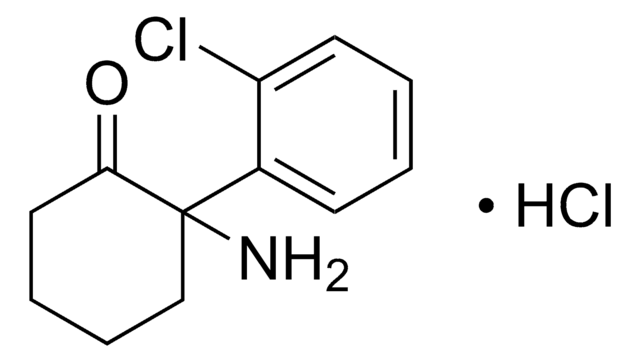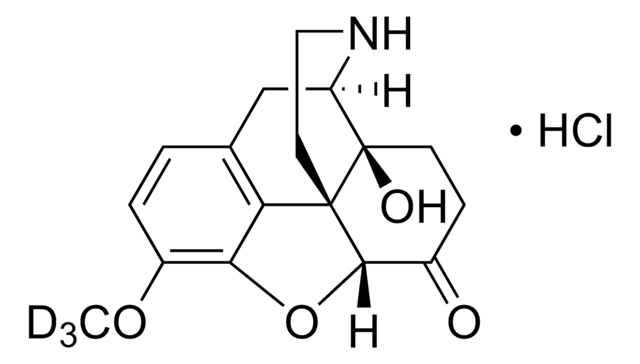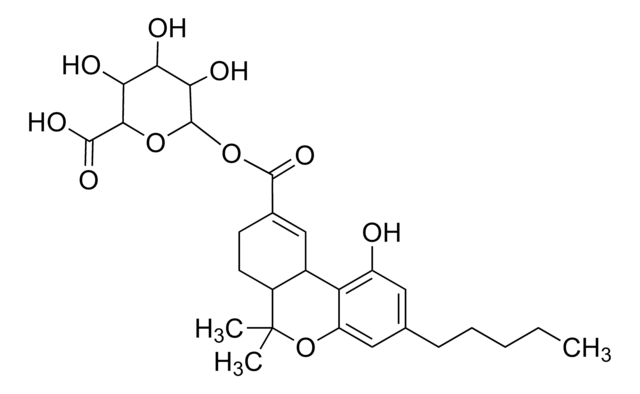M-031
Morphine-3-β-D-glucuronide solution
1 mg/mL in methanol with 0.05% NaOH, ampule of 1 mL, certified reference material, Cerilliant®
About This Item
Recommended Products
grade
certified reference material
Quality Level
form
liquid
packaging
ampule of 1 mL
manufacturer/tradename
Cerilliant®
drug control
Narcotic Licence Schedule A (Switzerland); estupefaciente (Spain); Decreto Lei 15/93: Tabela IA (Portugal)
concentration
1 mg/mL in methanol with 0.05% NaOH
technique(s)
gas chromatography (GC): suitable
liquid chromatography (LC): suitable
application(s)
forensics and toxicology
format
single component solution
storage temp.
2-8°C
SMILES string
O[C@@H](C=C1)[C@H]2[C@](C1[C@H]3C4)(CCN3C)C5=C4C=CC(O[C@H]6[C@H](O)[C@@H](O)[C@H](O)[C@@H](C(O)=O)O6)=C5O2
InChI
1S/C23H27NO9/c1-24-7-6-23-10-3-4-12(25)20(23)32-18-13(5-2-9(14(18)23)8-11(10)24)31-22-17(28)15(26)16(27)19(33-22)21(29)30/h2-5,10-12,15-17,19-20,22,25-28H,6-8H2,1H3,(H,29,30)/t10?,11-,12+,15+,16+,17-,19+,20+,22-,23+/m1/s1
InChI key
WAEXKFONHRHFBZ-RURUVCMVSA-N
Looking for similar products? Visit Product Comparison Guide
General description
Application
- Morphine-3-β-ᴅ-glucuronide (M3G) Solution in Clinical Analysis: The use of M3G glucuronide standard in liquid chromatography-tandem mass spectrometry has been validated for quantifying analgesics and sedatives in human plasma, with applications in intensive care and neurological death determination studies. This underlines the solution′s critical role in pharmacokinetic research of morphine metabolites within pharmaceutical sciences (Jutras et al., 2020).
- Opioid Metabolite Research with M3G: Analysis of opiate and opiate metabolites, including M3G, in urine after consumption of cold syrups by LC-MS/MS, emphasizes the solution′s importance in biochemical assays of morphine derivatives. This research is integral for monitoring drug abuse and optimizing therapeutic strategies in the pharma and biotech sectors (Yen YT et al., 2020).
- Electrophoresis-based Determination of M3G: Capillary electrophoresis-mass spectrometry has determined morphine and its isobaric glucuronide metabolites, including M3G, as an essential biochemistry tool for studying opioid metabolism. Such methods enable accurate profiling of drug metabolism, serving both research and clinical diagnostic purposes (Isbell TA et al., 2015).
- M3G Metabolism and UGT2B7 Enzyme: The catalysis of M3G glucuronidation and glucosidation by UDP-glucuronosyltransferase 2B7 highlights the solution′s use in uncovering complementary metabolic pathways of morphine. The findings have significant implications for the biochemist′s understanding of drug metabolism pathways in pharmaceutical research (Chau N et al., 2014).
- Stability Assessment in Sewage Epidemiology: The stability of drug biomarkers, including M3G in municipal wastewater, influences the estimation of drug consumption. Using high-purity M3G solution as a research standard aids in sewage epidemiology and environmental monitoring (Senta I et al., 2014).
Legal Information
related product
Signal Word
Danger
Hazard Statements
Precautionary Statements
Hazard Classifications
Acute Tox. 3 Dermal - Acute Tox. 3 Inhalation - Acute Tox. 3 Oral - Flam. Liq. 2 - STOT SE 1
Target Organs
Eyes,Central nervous system
Storage Class Code
3 - Flammable liquids
WGK
WGK 2
Flash Point(F)
51.8 °F - closed cup
Flash Point(C)
11 °C - closed cup
Regulatory Listings
Regulatory Listings are mainly provided for chemical products. Only limited information can be provided here for non-chemical products. No entry means none of the components are listed. It is the user’s obligation to ensure the safe and legal use of the product.
FSL
Group 4: Flammable liquids
Alcohols
Hazardous rank II
ISHL Indicated Name
Substances Subject to be Indicated Names
ISHL Notified Names
Substances Subject to be Notified Names
JAN Code
M-031-CC:
M-031-1ML:
Certificates of Analysis (COA)
Search for Certificates of Analysis (COA) by entering the products Lot/Batch Number. Lot and Batch Numbers can be found on a product’s label following the words ‘Lot’ or ‘Batch’.
Already Own This Product?
Find documentation for the products that you have recently purchased in the Document Library.
Protocols
To optimize hydrolysis using β-glucuronidase, factors such as incubation time, temperature, hydrolysis pH, enzyme source, and enzyme concentration must be evaluated for each glucuronide metabolite to be analyzed.
Our team of scientists has experience in all areas of research including Life Science, Material Science, Chemical Synthesis, Chromatography, Analytical and many others.
Contact Technical Service









